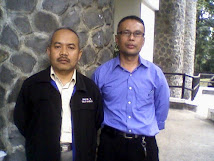Diasuh Oleh:
Bapak Itam Kistamaji S.Si.
(SMAN 1 Banjar)

dan
Arip Nurahman
(Indonesia University of Education & MIT Open Course Ware U.S.A.)


Applications and Influence
Applied physics is a general term for physics which is intended for a particular use; thus happiness can come from a successful application of the science. "Applied" is distinguished from "pure" by a subtle combination of factors such as the motivation and attitude of researchers and the nature of the relationship to the technology or science that may be affected by the work.[32] Applied Physics curriculum will usually contain a few classes from the applied disciplines, like chemistry, computer science, or electrical engineering. It usually differs from engineering in that an applied physicist may not be designing something in particular, but rather is using physics or conducting physics research with the aim of developing new technologies or solving a problem. The approach is similar to that of applied mathematics. Applied physicists can also be interested the use of physics for scientific research. For instance, people working on accelerator physics might seek to build better particle detectors for research in theoretical physics.
Physics is used heavily in engineering. Statics, a subfield of mechanics, is used in the building of bridges or other structures; the simple machines such as the lever and the ramp had to be discovered before they could be used; today, they can be taught to schoolchildren. The understanding and use of acoustics will result in better concert halls; similarly, the use of optics creates better optical devices. An understanding of physics makes for more realistic flight simulators, video games, and movies, as well as in forensic investigations (what do we know and when do we know it; what did the subject know and when did the subject know it).
Because of its historical relationship to the development of scientific method, physics reasoning can handle items which would ordinarily be mired in conundrums or uncertainty. For example, in the History of Earth#Origin, one can reasonably model Earth's mass, temperature, and rate of rotation, over time. From these values, the chemical composition of Earth at differing epochs can be posited. Even if a precise linear timeline might be problematic, qualitative statements can then be made about the history of Earth, which are still founded in the laws of physics.
There are many fields of physics which have strong applied branches, as well as many related and overlapping fields from other disciplines that are closely related to applied physics.
- Acoustics, the study of sound waves, is used everywhere we wish to hear, for example in music, speech, and audible alarms.
- Agrophysics is the study of the physics in agronomy.
- Biophysics is the interface of biology and physics.
- Chemical physics studies the structure and dynamics of ions, free radicals, polymers, clusters, and molecules, using both classical and quantum mechanical viewpoints.
- Communications has used physics extensively, for example in the Bell Laboratories. The first communications satellite appeared 300 years after Newton.
- Econophysics is the interface of economics and physics.
- Engineering physics graduates specialists in optics, nanotechnology, control theory, aerodynamics, or solid-state physics.
- Fluid mechanics is the study of fluids (liquids and gases) at rest and in motion. The Navier-Stokes equations are used in supercomputers to model Earth's weather.
- Geophysics is the physics of Earth.
- Lasers and radar were developed in the laboratories, used by the military, and now have extensive peacetime uses. Quantum electronics includes the study of lasers.
- Materials science is the systematic study of the properties of materials.
- Medical physics includes the standards for radiation exposure and infrastructure for radiology.
- Nanotechnology studies the creation of machines less than a micrometer in size.
- Optics has existed as a science for over 1000 years. Like acoustics, it has its own journals, practitioners, and university departments, as well as industries which utilize those graduates.
- Optoelectronics creates devices which use light rather than current.
- Photovoltaics, or solar cells, promise to generate current from light.
- Physical chemistry
- Physics of computation must rely upon the state of the art. For example, the accuracy of a computation depends on the ability to manufacture to tolerance, which was the undoing of Babbage's difference engine. Babbage's design worked when built with twentieth century technology.
- Plasma physics is the physics of an ionized gas.
- Quantum chemistry models matter using quantum mechanics.
- Quantum information science applies qubit devices.
- Solid state physics, including the material properties of semiconductor devices and integrated circuits.
Engineering utilizes physics in service of technology rather than science.
- Vehicle dynamics is a form of kinematics.
Applied physics
From Wikipedia
Applied physics is a general term for physics which is intended for a particular technological or practical use. "Applied" is distinguished from "pure" by a subtle combination of factors such as the motivation and attitude of researchers and the nature of the relationship to the technology or science that may be affected by the work.[1] It usually differs from engineering in that an applied physicist may not be designing something in particular, but rather is using physics or conducting physics research with the aim of developing new technologies or solving an engineering problem. This approach is similar to that of applied mathematics. In other words, applied physics is rooted in the fundamental truths and basic concepts of the physical sciences but is concerned with the utilization of these scientific principles in practical devices and systems. Applied physicists can also be interested in the use of physics for scientific research. For instance, people working on accelerator physics seek to build better accelerators for research in theoretical physics.
Fields and areas of research
- Accelerator physics
- Acoustics
- Agrophysics
- Ballistics
- Biophysics
- Computational physics
- Communication Physics
- Econophysics
- Engineering physics
- Fiber Optics
- Fluid dynamics
- Laser physics
- Force microscopy and imaging
- Geophysics
- Quantum electronics
- Medical physics
- Microfluidics
- Nanotechnology
- Nondestructive testing
- Nuclear engineering
- Nuclear technology
- Optics
- Optoelectronics
- Analog Electronics
- Digital Electronics
- Microprocessor Interfacing
- Signals And Systems
- Photovoltaics
- Plasma physics
- Semiconductor physics and devices
- Soil Physics
- Solid state physics
- Superconductors
- Space physics
- Spintronics
- Vehicle dynamics
- Metrological Physics
Prominent institutions
- Department of Applied Physics, California Institute of Technology
- Department of Applied Physics, Stanford University
- Department of Applied Physics and Applied Mathematics, Columbia University
- Applied Physics Laboratory, Johns Hopkins University
- Department of Applied Physics, University of Calcutta
- Institute of Applied Physics, Corrensstr
- School of Applied and Engineering Physics, Cornell University
- Department of Physics, Applied Physics & Astronomy, Rensselaer Polytechnic Institute
- Institute for Research in Electronics and Applied Physics, University of Maryland
- Department of Applied Physics, University of Michigan
- Department of Applied Physics, University of Karachi,Pakistan
- Department of Physics, Applied and Engineering Physics, Kettering University
- Department of Engineering Physics, Faculty of Industrial Technology, Institut Teknologi Bandung, Indonesia







Tidak ada komentar:
Posting Komentar